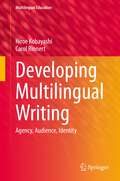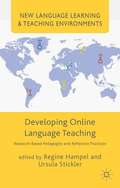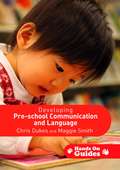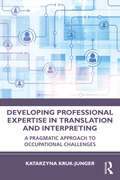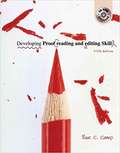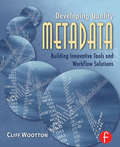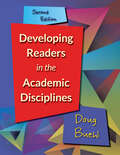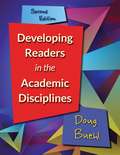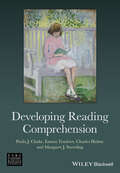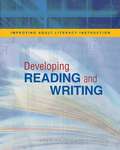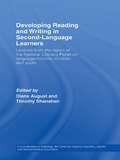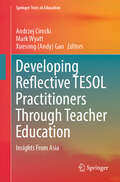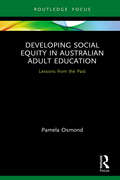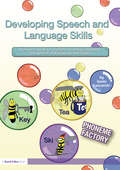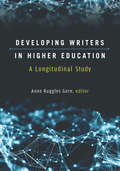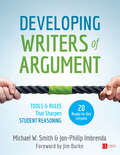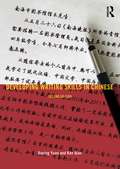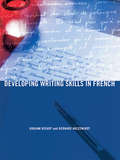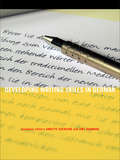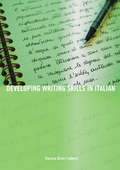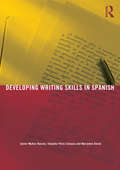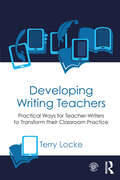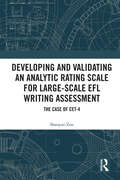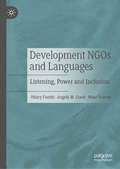- Table View
- List View
Developing Multilingual Writing: Agency, Audience, Identity (Multilingual Education #42)
by Hiroe Kobayashi Carol RinnertWith millions of people becoming multilingual writers in the globalized digital world, this book helps to empower writers to connect with their readers and project their identities effectively across languages, social contexts, and genres. In a series of closely-related studies that build on each other, we look comprehensively at how writers develop their ability to construct meaning for different audiences in multiple languages. This book, which draws on various approaches (including a social view of writing, multicompetence, adaptive transfer, complex systems theory, motivation, and translanguaging), contributes to on-going efforts to integrate differing approaches to multilingual writing research. This book focusses on how writer agency (control over text construction), audience awareness (ability to meet expectations of prospective readers), and writer identity (projection of image of the writer in the text) progress as multilingual writers gain more experience across languages. The within-writer, cross-sectional text analysis (Chapters 2-5) examines 185 essays written in Japanese and English by eight groups of writers from novice to advanced (N=103), supplemented by insights from these writers’ reflections. We explore how they employ three kinds of text features (discourse types, metadiscourse, and self-representation), which relate to their developing agency, audience, and writer identity in their text construction, and propose a new model for writer voice construction based on those features. The four case studies (Chapters 6-9) focus on five university students and six professionals to examine closely how individual writers’ agency, audience, and identity are interrelated in their text construction in two or three languages and diverse genres, including academic and creative writing. The combined studies provide new insights into multilingual writing development by revealing the close interrelationship among these three principal aspects of writing across languages. They also demonstrate the writers’ multi-directional use of dynamic transfer (reuse and reshaping) for L1, L2, and L3 text construction, and the use of mixed languages L1/L2 or L1/L3 (translanguaging) for composing processes, in addition to the creative power of multilingual writers.One significant contribution of this book is to provide models of innovative ways to analyze text and new directions for writing research that go beyond complexity, accuracy, and fluency. Categories and detailed examples of text features used for writer voice construction (e.g., specific characteristics of Personal, Emergent, and Mature Voice) are helpful for writing teachers and for developing writers to improve ways of conveying their own intended writer identity to the reader. The studies break new ground by extending our analysis of L2 writing to the same writers’ L1 and L3 writing and multiple genres.
Developing Online Language Teaching
by Regine HampelWhen moving towards teaching online, teachers are confronted every day with issues such as online moderation, establishing social presence online, transitioning learners to online environments, giving feedback online. This book supports language teaching professionals and researchers who are keen to engage in online teaching and learning.
Developing Pre-School Communication and Language (Hands on Guides)
by Maggie Smith Chris DukesIncludes CD-Rom `This book is highly recommended for all practitioners interested in improving their practice in developing young children's communication and language. The ability to print material form the CD-Rom enables the information to be accessed by practitioners working with children of different ages in different rooms in a setting' - Early Years Update `A very clear and easy to read style of text. . . This book has a common sense approach to good practice. I thoroughly recommend this book to anyone wishing to develop this area of childminding work' - National Childminding Association `An excellent resource for all those working with young children. . . the ideas are tried and tested, user-friendly and research-based, and can be trusted and implemented with ease' - Early Years Educator `This book will be an invaluable support: a treasure-chest of superb resources, materials, ideas and suggestions for the busy early years practitioner who is keen to develop the language of the children in their care. The CD-ROM will save some of that precious time we all strive to expand, and the practical strategies offered will be a boon to practice in the setting' - Collette Drifte Looking for advice on how to develop communication and language skills in the pre-school? Packed with helpful advice on supporting and developing the crucial language and communication skills of the children in your early years setting, this book provides clear guidance on appropriate expectations for each age group between birth to five. The book includes: - advice on how to support language development in all children, including those with special educational needs - practical ideas and strategies for practitioners and parents - guidance on when to seek advice and working with other professionals - activities and case studies - a CD Rom with useful photocopiable resources. This book is ideal for all those working with the 0 to 5 age range, such as pre-school practitioners, nursery managers, advisory teachers, SENCOs, Inclusion Officers and Child Care and Education students and tutors. Chris Dukes and Maggie Smith are both Area SENCOs who work closely with pre-school SENCOs and Managers on a daily basis.
Developing Professional Expertise in Translation and Interpreting: A Pragmatic Approach to Occupational Challenges
by Katarzyna Kruk-JungerDeveloping Professional Expertise in Translation and Interpreting covers what professional expertise means for translators and interpreters in the fast-changing, globalised world and how it can be achieved in practice.The book offers tactics and solutions for everyday issues, such as competence, etiquette, cultural differences, the translator’s role in communication, dealing with mistakes and using new technologies, using real-life examples of the occupational challenges practitioners face in their line of work. These range from translating Donald Trump’s controversial political tweets or interpreting during Oscar Pistorius’ high-profile court trial.This user-friendly guide helps students in translator training, or professionals starting out as translators and interpreters, establish good working standards and offers pragmatic solutions to common professional dilemmas for more experienced translators and interpreters.This is also an ideal resource for professors creating curricula in the area of ethics and etiquette within translation and interpreting, offering an interdisciplinary approach and an overview of the literature regarding all key topics.
Developing Proofreading And Editing Skills
by Sue C. CampDeveloping Proofreading and Editing Skills, 5/e by Camp provides instruction and applications designed to sharpen skills in detecting and correcting errors in written communications including memos, letters, reports, email messages, databases, presentation slides, advertisements, and spreadsheets. The material progresses from easy-to-recognize errors to those more difficult to spot, allowing students to build confidence and skill. Highlights of the 5th edition include a discussion of voice-recognition technology and proofreading and editing, end-of-chapter text applications with two applications in each chapter available on CD-ROM, and a series of seven review modules offering challenging proofreading practice.
Developing Quality Metadata: Building Innovative Tools and Workflow Solutions
by Cliff WoottonWith the explosion of new audio and video content on the Web, it's more important than ever to use accurate and comprehensive metadata to get the most out of that content. Developing Quality Metadata is an advanced user guide that will help you improve your metadata by making it accurate and coherent with your own solutions. This book is designed to get you thinking about solving problems in a proactive and productive way by including practical descriptions of powerful programming tools and user techniques using several programming languages. For example, you can use shell scripting as part of the graphic arts and media production process, or you can use a popular spreadsheet application to drive your workflow. The concepts explored in this book are framed within the context of a multimedia professional working on the Web or in broadcasting, but they are relevant to anyone responsible for a growing library of content, be it audio-visual, text, or financial.
Developing Readers in the Academic Disciplines
by Doug BuehlBeing literate in an academic discipline is more than being able to read and comprehend text; you can think, speak, and write as a historian, scientist, mathematician, or artist. Author Doug Buehl strips away the one-size-fits-all approach to content area literacy and presents an instructional model for disciplinary literacy, which honors the discipline and helps students learn within that area. In this revised second edition, Developing Readers in the Academic Disciplines shows how to help students adjust their thinking to comprehend a range of complex texts that fall outside their reading comfort zones. Inside you'll find: Instructional tools that adapt generic literacy practices to discipline-specific variationsStrategies for frontloading instruction to activate and build background knowledgeNew approaches for encouraging inquiry around disciplinary textsIn-depth exploration of the role of argumentation in informational textNumerous examples from science, mathematics, history and social studies, English/language arts, and related arts to show you what vibrant learning looks like in various classroom settings Designed to be a natural companion to Buehl's Classroom Strategies for Interactive Learning, Developing Readers in the Academic Disciplines introduces teachers from all disciplines to new kinds of thinking and, ultimately, teaching that helps students achieve new levels of understanding.
Developing Readers in the Academic Disciplines (2nd Edition)
by Doug Buehl<p>Being literate in an academic discipline means more than simply being able to read and comprehend text; it means you can think, speak, and write as a historian, scientist, mathematician, or artist. Doug Buehl strips away the one-size-fits-all approach to content area literacy and presents a much-needed instructional model for disciplinary literacy, showing how to mentor middle and high school learners to become "academic insiders" who are college and career ready. <p>This thoroughly revised second edition of Developing Readers in the Academic Disciplines shows how to help students adjust their thinking to comprehend a range of complex texts that fall outside their reading comfort zones. This book --a natural companion to Buehl's Classroom Strategies for Interactive Learning, which has been bolstering student comprehension for almost three decades--provides the following supports for teachers: <p> <li>Instructional tools that adapt generic literacy practices to discipline-specific variations <li>Strategies for frontloading instruction to activate and build background knowledge <li>New approaches for encouraging inquiry around disciplinary texts <li>In-depth exploration of the role of argumentation in informational text <li>Numerous examples from science, mathematics, history and social studies, English/language arts, and related arts to show you what vibrant learning looks like in various classroom settings</li> <p> <p>Developing Readers in the Academic Disciplines introduces teachers from all disciplines to new kinds of thinking and, ultimately, teaching that helps students achieve new levels of understanding.
Developing Reading Comprehension
by Charles Hulme Emma Truelove Margaret J. Snowling Paula J. ClarkePresents cutting-edge, evidence-based interventions for dealing with specific difficulties of reading comprehension in children aged 7-11. An in-depth introduction to the ‘poor comprehender profile’, which describes children who despite being fluent readers have difficulty extracting meaning from text. Sets out a range of practical interventions for improving reading skills in this group - along with comprehensive guidance on assessment and monitoring, and insightful accounts of professionals’ experience in delivering the techniques described. Includes an overview of psychological theories of reading comprehension, evaluating their practical applicability.
Developing Reading and Writing
by M. ChiangMore than an estimated 90 million adults in the United States lack the literacy skills needed for fully productive and secure lives. The effects of this shortfall are many: Adults with low literacy have lower rates of participation in the labor force and lower earnings when they do have jobs, for example. They are less able to understand and use health information. And they are less likely to read to their children, which may slow their children's own literacy development. At the request of the U. S. Department of Education, the National Research Council convened a committee of experts from many disciplines to synthesize research on literacy and learning in order to improve instruction for those served in adult education in the U. S. The committee's report, Improving Adult Literacy Instruction: Options for Practice and Research, recommends a program of research and innovation to gain a better understanding of adult literacy learners, improve instruction, and create the supports adults need for learning and achievement. Improving Adult Literacy Instruction: Developing Reading and Writing, which is based on the report, presents an overview of what is known about how literacy develops the component skills of reading and writing, and the practices that are effective for developing them. It also describes principles of reading and writing instruction that can guide those who design and administer programs or courses to improve adult literacy skills. Although this is not intended as a "how to" manual for instructors, teachers may also find the information presented here to be helpful as they plan and deliver instruction.
Developing Reading and Writing in Second-Language Learners: Lessons from the Report of the National Literacy Panel on Language-Minority Children and Youth. Published by Routledge for the American Association of Colleges for Teacher Education
by Timothy Shanahan Diane AugustA Co-Publication of Routledge, the Center for Applied Linguistics, and the International Reading Association This book is a shorter version of Developing Literacy in Second-Language Learners, reporting the findings of the National Literacy Panel on Language-Minority Children and Youth. This book concisely summarizes what is known from empirical research about the development of literacy in language-minority children and youth, including development, environment, instruction, and assessment. This more accessible version of the full report is intended for teachers, administrators, and researchers and for use in a wide range of teacher preparation courses and in inservice/ staff development programs that deal with educating English language learners. Visit www.reading.org for more information about IRA books, membership, and other services. Visit www.cal.org to learn more about the Center for Applied Linguistics.
Developing Reflective TESOL Practitioners Through Teacher Education: Insights From Asia (Springer Texts in Education)
by Xuesong Andy Gao Andrzej Cirocki Mark WyattThis textbook provides insights from Asian contexts into how reflective practice is nurtured on Teaching English to Speakers of Other Languages (TESOL) and English Language Teaching (ELT) teacher education programmes. There is increasing recognition worldwide that, given the centrality of reflective practice to teachers’ ongoing professional development, supporting teachers to become reflective practitioners should be integral to teacher education programmes. Consequently, tertiary-level courses in areas such as TESOL and ELT tend to promote reflective practice, supported by theoretical input from the burgeoning literature on reflection, much of which is produced in the West. Relatively under-represented in the literature are global perspectives on reflective practice; there are consequently relatively few accounts as to how reflective practice is embedded in teacher education programmes in different parts of the world, including Asia. Hence, this book addresses a gap. Contributing authors from fourteen countries provide insights into the ways in which teachers are helped to grow as reflective practitioners on their teacher education programmes in their unique contexts. This textbook showcases how reflective teaching practices are developed, supported by frameworks for critical reflection and in interaction with local educational policies. These distinctive accounts aid readers in reflecting on the ways in which reflective practice is supported in their own teacher education contexts and in considering ways of enhancing the reflective dimension of their programmes. This textbook showcases innovative reflective activities and can be used as a principal text or as supplemental reading on a range of TESOL and ELT teacher education courses.
Developing Social Equity in Australian Adult Education: Lessons from the Past
by Pamela OsmondDeveloping Social Equity in Australian Adult Education: Lessons from the Past presents a case study of the trajectory of an Australian adult basic education program in New South Wales from its humanist, social justice beginnings, through forty years of destabilising change. It identifies the influences and influencers that have directed this change; those that were responsible for the creation of the field in its foundation years, and that were displaced by other, more powerful actors representing the global influence of the neoliberal ideology. The story is told largely through archival evidence and the voices of those practitioners who helped shape the discourse and practice of the foundation years, and who were required to respond to constantly changing policies and socio-economic contexts. It discusses some lessons that might be learnt from the past in order that a new set of actors might be mobilised to promote an alternate discourse. This book will appeal to students and scholars of social justice and adult education, and practitioners involved in adult education.
Developing Speech and Language Skills: Phoneme Factory
by Gwen LancasterThis book is part of the Phoneme Factory Project undertaken by Granada Learning in partnership with the Speech and Language Therapy Research Unit (SLTRU) in Bristol. It aims to provide guidance for teachers, SENCos, SLTs and parents regarding: criteria for referral to speech and language therapy phonological disorders appropriate intervention approaches that can be used in the classroom and at home. Complementing the book is a CD containing downloadable resources including a picture library for the classroom and the home, as well as checklists and other time-saving documents.
Developing Writers in Higher Education: A Longitudinal Study (Sweetland Digital Rhetoric Collaborative)
by Anne R GereFor undergraduates following any course of study, it is essential to develop the ability to write effectively. Yet the processes by which students become more capable and ready to meet the challenges of writing for employers, the wider public, and their own purposes remain largely invisible. Developing Writers in Higher Education shows how learning to write for various purposes in multiple disciplines leads college students to new levels of competence. This volume draws on an in-depth study of the writing and experiences of 169 University of Michigan undergraduates, using statistical analysis of 322 surveys, qualitative analysis of 131 interviews, use of corpus linguistics on 94 electronic portfolios and 2,406 pieces of student writing, and case studies of individual students to trace the multiple paths taken by student writers. Topics include student writers’ interaction with feedback; perceptions of genre; the role of disciplinary writing; generality and certainty in student writing; students’ concepts of voice and style; students’ understanding of multimodal and digital writing; high school’s influence on college writers; and writing development after college. The digital edition offers samples of student writing, electronic portfolios produced by student writers, transcripts of interviews with students, and explanations of some of the analysis conducted by the contributors. This is an important book for researchers and graduate students in multiple fields. Those in writing studies get an overview of other longitudinal studies as well as key questions currently circulating. For linguists, it demonstrates how corpus linguistics can inform writing studies. Scholars in higher education will gain a new perspective on college student development. The book also adds to current understandings of sociocultural theories of literacy and offers prospective teachers insights into how students learn to write. Finally, for high school teachers, this volume will answer questions about college writing.
Developing Writers of Argument: Tools and Rules That Sharpen Student Reasoning (Corwin Literacy)
by Michael W. Smith Jon-Philip ImbrendaThe ability to make effective arguments is not only necessary in students’ academic lives, it’s a transferable skill that’s essential to students’ future success as critical thinkers and contributing members of society. But in the here and now, how do we engage students and ensure they understand argument writing’s fundamental components? How do we take them from "Here’s what I think" to "Here’s what I think. Here’s what makes me think that. And here’s why it matters"? This stunning, full-color book by Michael Smith and Jon-Philip Imbrenda shows the way, with ready-to-implement lessons that make argument writing topical and relevant. Students are first asked to form arguments about subjects that matter to them, and then to reflect on the structure of those arguments, a process that provides learners with valuable, reusable structural models. Throughout the book, the authors provide helpful instructional tools, including Literary, nonfiction, and author-created simulated texts that inspire different points of view Essential questions to create a context that rewards argumentation Lessons introducing students to the three essential elements of an argument—claim, data, and warrant—and how to make each effective Questioning probes, semantic differential scales, and other innovative instructional approaches Samples of writing from the authors’ own students, and enlightening details on how this work informed the authors’ subsequent teaching approach Complete with guidance on applying the lessons’ techniques in a broader, unit-wide context, Developing Writers of Argument offers a practical approach for instructing students in this crucial aspect of their lifelong development.
Developing Writers of Argument: Tools and Rules That Sharpen Student Reasoning (Corwin Literacy)
by Michael W. Smith Jon-Philip ImbrendaThe ability to make effective arguments is not only necessary in students’ academic lives, it’s a transferable skill that’s essential to students’ future success as critical thinkers and contributing members of society. But in the here and now, how do we engage students and ensure they understand argument writing’s fundamental components? How do we take them from "Here’s what I think" to "Here’s what I think. Here’s what makes me think that. And here’s why it matters"? This stunning, full-color book by Michael Smith and Jon-Philip Imbrenda shows the way, with ready-to-implement lessons that make argument writing topical and relevant. Students are first asked to form arguments about subjects that matter to them, and then to reflect on the structure of those arguments, a process that provides learners with valuable, reusable structural models. Throughout the book, the authors provide helpful instructional tools, including Literary, nonfiction, and author-created simulated texts that inspire different points of view Essential questions to create a context that rewards argumentation Lessons introducing students to the three essential elements of an argument—claim, data, and warrant—and how to make each effective Questioning probes, semantic differential scales, and other innovative instructional approaches Samples of writing from the authors’ own students, and enlightening details on how this work informed the authors’ subsequent teaching approach Complete with guidance on applying the lessons’ techniques in a broader, unit-wide context, Developing Writers of Argument offers a practical approach for instructing students in this crucial aspect of their lifelong development.
Developing Writing Skills in Chinese
by Boping Yuan Kan QianDeveloping Writing Skills in Chinese has been devised for post-intermediate students who need to write Chinese in the course of their life, work or study. Each unit covers a specific style of writing and is reinforced with a rich selection of model texts. All texts are followed by supporting notes examining the formats, styles, grammar structures or special phrases featured. A wide variety of exercises are featured throughout, and each unit concludes with a helpful glossary given in Chinese characters, pinyin and English translations. An answer key is also included in the back of the book. The following writing styles and genres are covered: Personal correspondence—greetings and condolences, explanations and apologising, making arrangements and keeping in touch Formal writing—announcements and adverts, letters of enquiry and application, business correspondence, developing an argument, facts and data Narration—story narratives, reporting speech, exemplifying and summarising Description and comparison—outlining people’s characters, physical attributes and appearance, places and weather This new edition has been comprehensively revised and updated throughout. It includes a brand-new chapter on narratives and there is new coverage of digital communication methods such as text messages and emails. An additional English-Chinese glossary is also available for free download at http://www.routledge.com/books/details/9780415678896/ Developing Writing Skills in Chinese will help students to write coherently, clearly and appropriately in a variety of contexts. It is suitable for both classroom and self-study use.
Developing Writing Skills in French
by Graham Bishop Bernard HaezewindtDesigned for intermediate to advanced students, this text equips readers with the necessary skills to write confidently in French in a range of situations. Suitable for use as a classroom text or as a self-study course, it is carefully structured to ensure a better understanding of the effect of choice of words, register and style.Each chapter contains a selection of model texts, activities and clear notes on the format, style and language demonstrated. Every activity also has a model answer in the key, which also offers advice, explanations and further examples to support the student's learning. Features include:* key learning points clearly indicated at the beginning of each chapter* a rich selection of model texts from a variety of different media.Based on a well-reviewed Open University course and written by experienced teachers of the language, Developing Writing Skills in French has been trialled with non-native speakers of French to produce a valuable resource that will help students write appropriately for a variety of contexts.
Developing Writing Skills in German
by Annette Duensing Uwe BaumannDeveloping Writing Skills in German, is a unique course designed to improve the reading and writing skills of intermediate students of German. Presenting a wide range of authentic written materials, the book aims to develop reading strategies and the ability to write texts of various types - essays, articles and reviews - while imparting an understanding of important aspects of German society. From the environment to consumerism, each chapter focuses on a different theme and concentrates on the advancement of particular skills; all the chapters conclude with a task appropriate to the skills focus of the section. Summary writing, note-taking, the use of mind-maps to collect ideas, and other strategies for successful writing in German are presented here. This course is suitable both for classroom use and independent study, with feedback and answer key supplied at the back of the book.
Developing Writing Skills in Italian (Developing Writing Skills)
by Theresa Oliver-FedericiDeveloping Writing Skills in Italian has been specifically designed for upper-intermediate students of Italian who need to write Italian for personal, business and academic purposes. With a strong focus on writing as a meaningful and valuable skill in itself, Developing Writing Skills in Italian supports the learner throughout the process of writing, from the planning and drafting stages to the revising and editing of a final version, enriching and extending the learners’ lexical, grammatical and communicative writing skills. Divided into four logically structured sections the learner can work through a range of realistic and contextualized writing tasks which will allow them to master a variety of styles, registers and formats. Features include: flexible structure a summary of learning points clearly indicated at the beginning of each chapter focus on self assessment, allowing students to engage fully in the writing process by evaluating their own work a glossary of key phrases and useful vocabulary. This course is suitable both for classroom use and independent study. Assessment guides, a teacher’s guide, answer key and supplementary activities are all available on the accompanying website.
Developing Writing Skills in Spanish (Developing Writing Skills Ser.)
by Javier Muñoz-Basols Marianne David Yolanda Pérez SinusíaDeveloping Writing Skills in Spanish provides intermediate and advanced level students with the necessary skills to become competent and confident writers in the Spanish language. With a focus on writing as a craft, Developing Writing Skills in Spanish offers a rich selection of original materials including narrative texts, expository essays, opinion pieces and newspaper articles. Each chapter covers a specific kind of writing and is designed to help tackle the material in small units. The book aids students in crafting clear, coherent and cohesive manuscripts by means of guided practice and step-by-step activities. Key features: Guidance on how to structure a variety of texts: narrative, descriptive, expository, argumentative, academic, journalistic, legal and scientific. Sequenced exercises on style, writing conventions, word choice, syntax and grammar. Reference lists and tables with specialized vocabulary, transition words and other useful expressions. Strategies and tips for planning manuscripts, brainstorming ideas, vocabulary enrichment, editing and proofreading. Includes original samples, as well as fragments from newspapers, well-known literary works and essays by notable Hispanic authors and journalists. Website with additional activities to reinforce the content of each chapter and a teacher's guide with valuable support materials at: www.developingwritingskills.com Designed as a classroom text, self-study material or simply as a resource on writing, Developing Writing Skills in Spanish is the ideal supplement for all intermediate to advanced students of Spanish.
Developing Writing Teachers: Practical Ways for Teacher-Writers to Transform their Classroom Practice
by Terry LockeThe premise of Developing Writing Teachers is this: When teachers of writing identify as writers, it adds a special dimension to their writing pedagogy. Practical and accessible while drawing on a range of relevant research and theory, this text is distinguished by its dual focus—on teachers as writers and the teaching of writing. Part I addresses the question, What does it take for a teacher of writing to develop an identity as writer? Using case studies and teacher narratives, it guides readers to an understanding of the current status of writing as the 21st century unfolds, the role of expressive writing in developing a writing identity, the relationship of writing to genre and rhetoric, writing and professional identity, and writing as design. Part II focuses on pedagogical practice and helping writer-teachers develop a toolkit to take into their classrooms. Coverage includes building a community of writing practice; the nature of writing as process; the place of grammar; the role of information, communication and representational technologies; and how assessment, properly used, can help develop writing. Ideal for for pre-service and in-service courses on the teaching of writing, the Companion Website provides aadditional readings/documents; PowerPoint presentations; assessment resources; and lesson and unit plans and planning guides.
Developing and Validating an Analytic Rating Scale for Large-Scale EFL Writing Assessment: The Case of CET-4
by Shaoyan ZouThe debate between holistic and analytical scoring methods in second language assessment has long persisted. This book addresses the effectiveness and validity of the holistic rating scale used in China’s high-stakes CET-4 (College English Test Band 4) writing tests via systematic case study analysis.Using a multi-phase, mixed-methods research methodology, the author creates and validates a new analytical rating scale that redefines and operationalizes critical aspects of writing assessment. Through extensive empirical evidence, including rater cognition studies, expert reviews, and Rasch-based descriptor calibration, the author reveals the limitations of holistic scoring systems and demonstrates the necessity and validity of analytical methods. The author convincingly argues that this new scoring method translates to a more transparent, fair, and diagnostic model for large-scale EFL writing assessment.This book is an essential reference for researchers in applied linguistics, language assessment, and English language education. It also offers valuable insights for assessment specialists, test developers, and language policymakers seeking more effective evaluation frameworks.
Development NGOs and Languages: Listening, Power and Inclusion
by Hilary Footitt Angela M. Crack Wine TesseurThis book addresses, for the first time, the question of how development NGOs attempt to 'listen' to communities in linguistically diverse environments. NGOs are under increasing pressure to demonstrate that they 'listen' to the people and communities that they are trying to serve, but this can be an immensely challenging task where there are significant language and cultural differences. However, until now, there has been no systematic study of the role of foreign languages in development work. The authors present findings based on interviews with a wide range of NGO staff and government officials, NGO archives, and observations of NGO-community interaction in country case studies. They suggest ways in which NGOs can reform their language policies to listen to the recipients of aid more effectively.
